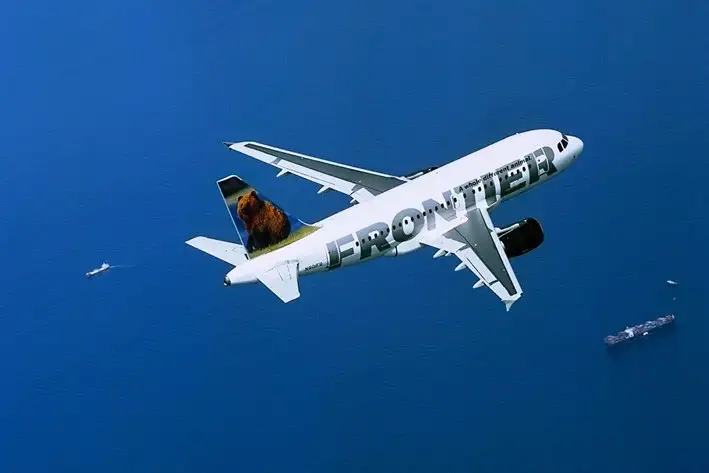
Frontier’s recent announcement that it was transforming itself into an “ultra-low-cost” airline was something of a misnomer: The only changes so far are to fares, not costs; and it should have said “ultra-low-fare” airline. Either way, however, the move raises the question about exactly what an ultra-low-fare airline does and who does it.
The “what” of it seems to be a cluster of pricing policies that differ from those of most other airlines, even self-styled low-fare lines such as Southwest:
- Base fares lower than the competition.
- Separate fees for everything other than just the seat, including carry-on baggage in the overhead bin, checked baggage, soft drinks, snacks, seat assignment, early boarding, use of a credit card (rather than a debit card), phone booking, and online booking.
- Route systems that emphasize point-to-point flying, rather than connecting itineraries through central hubs.
- Extremely tight seating.
- Higher fees for almost everything when you buy at the airport rather than online, in advance.
Within that context, most industry observers and most travelers would put Allegiant and Spirit in that category. In Europe, EasyJet and Ryanair are also in the ultra-low-fare club. Although they share many characteristics, however, each line has its own unique features.
Frontier is the latest to seize on the ultra-low-fare formula. It now offers two basic fare levels: economy fares lower than previous levels and “classic plus” fares, including a checked bag, a carry-on bag, no-charge itinerary change, name change on ticket, no charge same-day standby, advance seat assignment, and improved access to upgraded seats.
Obviously, airlines change fare structures because they expect improved profits. So how can cutting base fares increase an airline’s profit? Simple: Frontier figures that it will take in more revenue, either in new fees or in sales of higher-priced “classic plus” tickets, than it took in before. On a typical medium-haul flight, classic plus costs $50 to $80 more than base economy, and Frontier knows that a lot of that increment goes to cover features that add nothing whatsoever to its costs. As before, high-level frequent flyers will see reduced fees.
Although Frontier is preaching the ultra-low-fare gospel, it’s not as well suited as the other lines to implement it. Changing fares does nothing to decrease costs. Its planes—A319s, A320s, and Embraer190s—have about the same legroom as most other lines’ models, and the comfortable Embraer is not an ideal choice for ultra-low. Also, Frontier has finagled its route structure steadily in recent years, with no clear end in sight. It now operates a large hub-and-spoke system at Denver and smaller point-to-point systems centered in Trenton, New Jersey, and Wilmington, Delaware. Don’t be surprised to see more important route changes before the dust settles. And look for other changes too, including tighter seating: Frontier’s key new managers are alumni of Spirit, and Frontier is likely to morph in that direction.
Among the established ultra-low-fare lines, Allegiant is unique. Its route focus is flying a few times a week from “nowhere to somewhere,” linking many cities too small to support conventional airline service with a handful of blockbuster destinations, notably Las Vegas, Phoenix, and popular resort centers in Florida, Hawaii, and California. It makes a lot of its revenue from selling airfares bundled with hotel accommodations and rental cars. Allegiant’s position in its market niche is strong, with no serious competitors. The main growth challenge is finding additional feature destinations; it has already pretty much tapped the supply of “nowhere” cities.
Spirit, too, follows the “lowest price, lousy product” formula with fees for everything. Its route structure, however, is totally unlike Allegiant’s: Spirit flies point-to-point routes wherever it senses a good market, including many where it competes head-to-head with major lines. Its “where we fly” map looks like that of a much larger airline, but frequencies are low on many routes.
Over the years, the giant “legacy” lines have been ruthless about killing off low-fare rivals. It remains to be seen how Frontier and Spirit can remain out of their crosshairs.
Ed Perkins on Travel is copyright (c) 2014 Tribune Media Services, Inc.
You Might Also Like:
We hand-pick everything we recommend and select items through testing and reviews. Some products are sent to us free of charge with no incentive to offer a favorable review. We offer our unbiased opinions and do not accept compensation to review products. All items are in stock and prices are accurate at the time of publication. If you buy something through our links, we may earn a commission.
Related
Top Fares From
Today's Top Travel Deals
Brought to you by ShermansTravel
Porto to Lisbon: 7-Nt, Small-Group Portugal...
Indus Travels
 vacation
$1899+
vacation
$1899+
Greenland: Luxe, All-Incl. 11-Nt Exploration Small-Ship...
Swan Hellenic



Ohio: Daily Car Rentals from Cincinnati
85OFF.com





